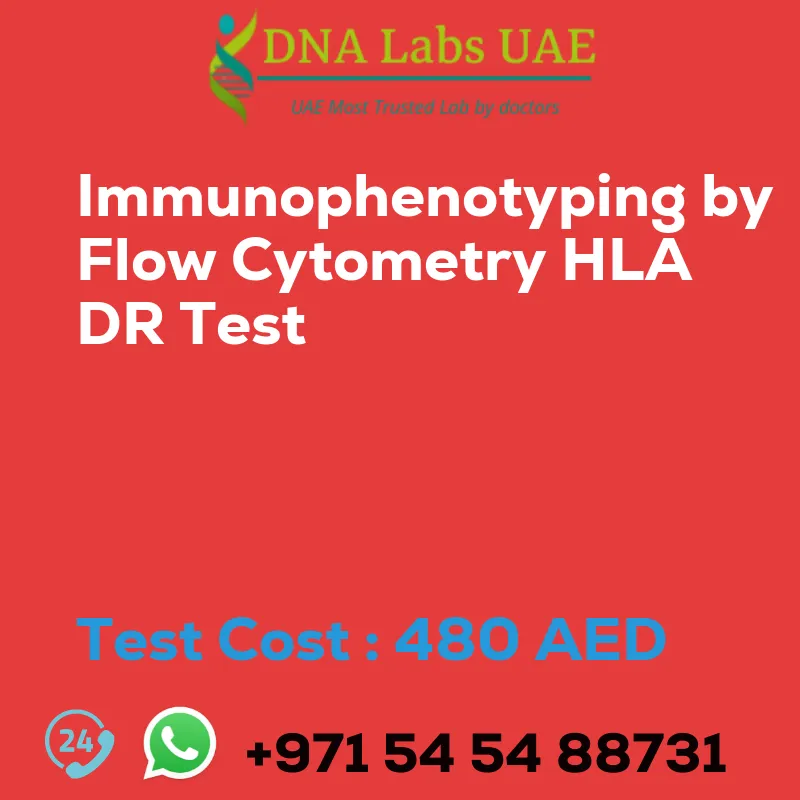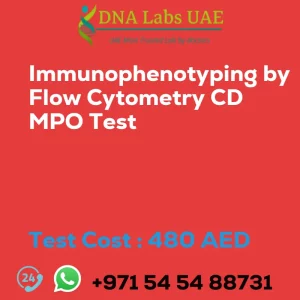IMMUNOPHENOTYPING BY FLOW CYTOMETRY HLA DR Test
At DNA Labs UAE, we offer the IMMUNOPHENOTYPING BY FLOW CYTOMETRY HLA DR Test at a cost of AED 480.0. This test is used to analyze the expression of human leukocyte antigen (HLA) class II antigen HLA-DR on immune cells using flow cytometry.
Test Details
The HLA-DR test is a type of immunophenotyping assay that uses flow cytometry to analyze the expression of HLA-DR on immune cells. HLA-DR is a cell surface receptor that plays a crucial role in the immune response by presenting antigens to T cells.
Flow cytometry is a technique that allows for the simultaneous analysis of multiple parameters on individual cells in a heterogeneous cell population. In the case of HLA-DR testing, blood or tissue samples are stained with fluorescently labeled antibodies specific for HLA-DR. These antibodies bind to HLA-DR molecules on the cell surface, allowing for their detection and quantification using flow cytometry.
During flow cytometry analysis, the stained cells are passed through a flow cytometer, which is a specialized instrument that measures the fluorescence emitted by the labeled antibodies. The instrument also collects information on other parameters, such as cell size and granularity, which can help distinguish different cell populations.
The data obtained from flow cytometry analysis is analyzed using specialized software, which allows for the identification and quantification of HLA-DR-positive cells within the sample. This information can be used to determine the proportion of immune cells expressing HLA-DR and to assess their activation status.
Test Type
The IMMUNOPHENOTYPING BY FLOW CYTOMETRY HLA DR Test falls under the category of cancer tests.
Doctor and Test Department
This test is typically ordered by oncologists and hematologists. It is conducted in our specialized FLOW CYTOMETRY department.
Pre Test Information
Prior to the test, please provide a brief clinical history to assist in the analysis.
Sample Condition and Report Delivery
The test requires a 3 mL (2 mL minimum) whole blood sample in 1 Lavender Top (EDTA) tube and a 3 mL (2 mL minimum) whole blood sample in 1 Green Top (Sodium Heparin) tube, or a 2 mL (1 mL minimum) bone marrow sample in 1 Green Top (Sodium Heparin) tube. The samples should be shipped immediately at 18-22°C and should not be refrigerated or frozen. Please specify the time, date, and clinical details on the test request form. The test results will be delivered within 1 week.
Uses and Benefits
The HLA-DR test is commonly used in clinical and research settings to evaluate immune system function and activation. It can be particularly useful in assessing immune responses in various disease states, such as autoimmune disorders, infectious diseases, and cancer. Additionally, the HLA-DR test can help monitor the effectiveness of immunotherapy treatments and guide therapeutic decision-making.
Conclusion
At DNA Labs UAE, we offer the IMMUNOPHENOTYPING BY FLOW CYTOMETRY HLA DR Test to assess the expression of HLA-DR on immune cells. This test provides valuable information about immune system function and activation, making it a valuable tool in diagnosing and monitoring various diseases. Contact us today to schedule your test.
| Test Name | IMMUNOPHENOTYPING BY FLOW CYTOMETRY HLA DR Test |
|---|---|
| Components | |
| Price | 480.0 AED |
| Sample Condition | 3 mL (2 mL min.) whole blood in 1 Lavender Top (EDTA) tubeAND 3 mL (2 mL min.) whole blood in 1 Green Top (Sodium Heparin) tube OR 2 mL (1 mL min.) Bone marrow in 1 Green Top (Sodium heparin) tube. Ship immediately at 18\u0192??22?\u00f8C. DO NOT REFRIGERATE OR FREEZE. Specify time, date and clinical details on test request form. |
| Report Delivery | 1 week |
| Method | Flow Cytometry |
| Test type | Cancer |
| Doctor | Oncologist, Hematologist |
| Test Department: | FLOW CYTOMETRY |
| Pre Test Information | Give brief clinical history. |
| Test Details |
The HLA-DR test is a type of immunophenotyping assay that uses flow cytometry to analyze the expression of human leukocyte antigen (HLA) class II antigen HLA-DR on immune cells. HLA-DR is a cell surface receptor that plays a crucial role in the immune response by presenting antigens to T cells. Flow cytometry is a technique that allows for the simultaneous analysis of multiple parameters on individual cells in a heterogeneous cell population. In the case of HLA-DR testing, blood or tissue samples are stained with fluorescently labeled antibodies specific for HLA-DR. These antibodies bind to HLA-DR molecules on the cell surface, allowing for their detection and quantification using flow cytometry. During flow cytometry analysis, the stained cells are passed through a flow cytometer, which is a specialized instrument that measures the fluorescence emitted by the labeled antibodies. The instrument also collects information on other parameters, such as cell size and granularity, which can help distinguish different cell populations. The data obtained from flow cytometry analysis is analyzed using specialized software, which allows for the identification and quantification of HLA-DR-positive cells within the sample. This information can be used to determine the proportion of immune cells expressing HLA-DR and to assess their activation status. The HLA-DR test is commonly used in clinical and research settings to evaluate immune system function and activation. It can be particularly useful in assessing immune responses in various disease states, such as autoimmune disorders, infectious diseases, and cancer. Additionally, the HLA-DR test can help monitor the effectiveness of immunotherapy treatments and guide therapeutic decision-making. |








